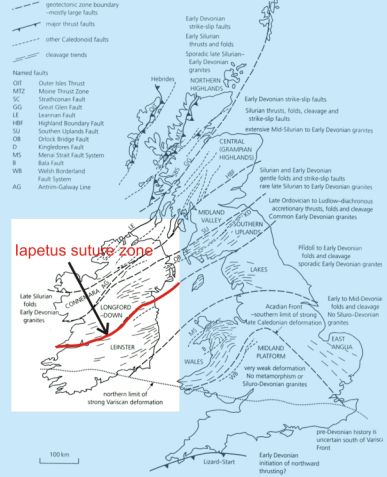Introduction
The Irish Seismic Lithospheric Experiment has been designed to investigate the lithospheric structure across the late-Caledonian Iapetus Suture Zone in South West Ireland. The projet is a collaboration between Geophysics Section (Dublin Institute for Advanced Studies) and Geophysical Institute (Karlsruhe University). This is also the first passive teleseismic experiment to be conducted in Ireland, building upon a large body of earlier work on the crustal structure, onshore Ireland, based on controlled source seismics and potential field studies.
This project is funded by Enterprise Ireland Basic Research Grant (SC/2001/155) and German collaboration is supported by Deutsche Forschungsgemeinschaft, Bonn (Grant Ri 1133/1). Eight SP mobile stations were borrowed from the Geophysical Instrument Pool at the GeoForschungsZentrum Potsdam.
|
Iapetus Suture Zone The Iapetus suture is regarded as the most important Caledonian structural feature in Britain and Ireland, running from the south-west Ireland, north-westward to Ireland' east coast, the north-west to the Isle of Man and into the Solway Firth along the England-Scotland border. The Iapetus suture, as a tectonic boundary representing consumed oceanic lithosphere, results from the amalgamation in the three plate configuration of Laurentia and Baltica with Avalonia during the closure of Iapetus Ocean in late Silurian and early Devonian (ca 400 my ago). Deformation fabrics also define oblique "left lateral" transpression within the suture zone. However, there is still debate about its exact surface trace of the suture since along most of its length it is obscured by post-Caledonian strata. |

|
Seismic evidence In the earlier VARNET (Variscan Front Networks) experiment in 1996 P-wave travel time residuals were observed across this zone using teleseismic sources (Masson et al., 1999).
| Aims The idea that the observed travel-time anomaly is due to seismic anisotropy in the mantle within the suture zone will be primarily tested using mainly converted teleseismic shear-wave energy. Spatial variations in seismic properties at various azimuths will be measured using shear wave splitting techniques with the array deployment pattern. The result will be compared with the geologically and geophysically mapped tectonic patterns within the Iapetus suture zone. Besides, the well-constrained crustal model will be constructed using receiver function and seismic tomography techniques. This experiment will hopefully image the 3-D extent of the suture zone into the upper mantle lithosphere.
|
References Masson, F., Hauser, F. and Jacob, A. W. B., 1999, The lithospheric trace of the Iapetus Suture in SW Ireland from teleseismic data: Tectonophysics, 302, 83-89. Todd, S. P., Murphy F. C. and Kennan, P. S., 1991, On the trace of the Iapetus suture in Ireland and Britain: Journal of Geo. Soc, 148, 869-880. Woodcock, N. H. and Strachan, R. A., 2000, The Caledonian Orogeny: a multiple plate collision, in Woodcock, N. H. and Strachan, R. A. (eds) Geological History of Britain and Ireland, Blackwell Science. |
Created and maintained by Van Chuong Do
E-mail: vcd@cp.dias.ie
Last Modification: 23 Feb 2004